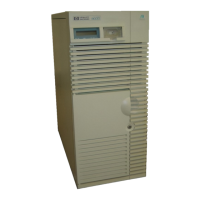3-32 Chapter 3
Troubleshooting
When you get the ISL prompt, type ODE to run the offline diagnostic environment. It
will take a few minutes to load ODE from tape. To get a list of the tests available, type ls
at the ODE prompt. ODE contains CPU, memory, and I/O tests, as well as a firmware
update tool. You can find a list of available diagnostics in Chapter 5 Diagnostics. You can
find detailed information about other offline diagnostics in the Diagnostic Manual set.
Operating System Problems
When an operating system problem occurs, the first step is to determine the type of
problem. The first symptom of a problem is that the system does not respond to user
input. This lack of response indicates either a performance problem or a system
interruption.
HP-UX System Hang
Use the recovery procedure in Table 3-14 to resolve the problem.
Table 3-14 HP-UX System Hang Troubleshooting
Performance
problem
The system responds to one or more programs/users, but the system response is
very slow.
System hang There is a complete loss of CPU resources for all users/programs. There is no
system response over a long period of time.
Symptoms Recovery Procedure
The machine is running, but no
one can access the system. The
system console may or may not
be hung.
If possible, wait about 15 minutes to see if the computer is
really hung or if it has performance problem. With some
performance problems, a computer may not respond to
user input for 15 min. or longer.
If the computer is really hung, perform a soft boot on the
machine by issuing a
TC
command. (Do NOT use the
RS
command if possible;
RS
may destroy important
troubleshooting information.)
Save the memory dump file (should be automatic) and call
the HP Response Center to have it analyzed.

